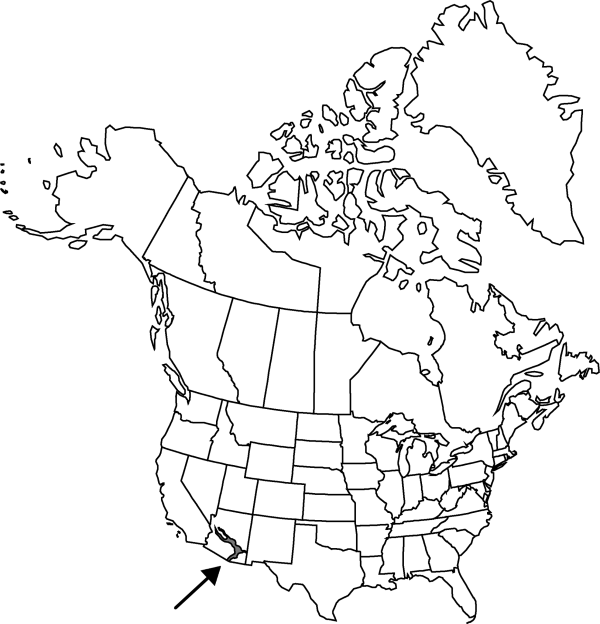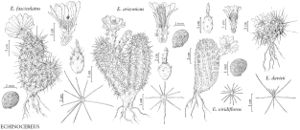FNA>Volume Importer |
FNA>Volume Importer |
| Line 31: |
Line 31: |
| | }}<!-- | | }}<!-- |
| | | | |
| − | --><span class="statement" id="st-d0_s0" data-properties="plant architecture;clump architecture"><b>Plants </b>5–30-branched, forming somewhat open clumps.</span> <span class="statement" id="st-d0_s1" data-properties="stem orientation;stem shape;stem atypical length;stem length;stem width"><b>Stems </b>mostly erect, cylindric, (5–) 10–40 × 4.5–8 cm;</span> <span class="statement" id="st-d0_s2" data-properties="rib count;crest shape">ribs 10–15, crests slightly undulate;</span> <span class="statement" id="st-d0_s3" data-properties="areole some measurement;areole arrangement">areoles 10–15 mm apart.</span> <span class="statement" id="st-d0_s4" data-properties="spine count;spine course;individual spine coloration;individual spine coloration;individual spine coloration;individual spine coloration;individual spine coloration;individual spine coloration;individual spine coloration;individual spine coloration;individual spine coloration;individual spine coloration;individual spine coloration;individual spine coloration;individual spine coloration;individual spine coloration;individual spine coloration;individual spine coloration;individual spine coloration;individual spine coloration;individual spine coloration;zone width;zone coloration"><b>Spines </b>8–16 per areole, usually straight, individual spines with broad zones of different colors: yellowish, reddish-brown, or gray to black, or white to black, becoming gray;</span> <span class="statement" id="st-d0_s5" data-properties="spine count;spine course;zone width;spine arrangement;spine count;spine some measurement">radial spines 7–15 per areole, 5–15 mm;</span> <span class="statement" id="st-d0_s6" data-properties="spine count;spine course;zone width;central spine count;central spine orientation;central spine some measurement;central spine shape">central spines 1–3 per areole, divergent-porrect, 15–75 mm, all terete.</span> <span class="statement" id="st-d0_s7" data-properties="flower length;flower width"><b>Flowers </b>6–10 × 8–10 cm;</span> <span class="statement" id="st-d0_s8" data-properties="flower tube length;flower tube width">flower tube 10–20 × 15–40 mm;</span> <span class="statement" id="st-d0_s9" data-properties="flower tube hair some measurement">flower tube hairs 2.3–4 mm;</span> <span class="statement" id="st-d0_s10" data-properties="inner tepal coloration;inner tepal coloration;inner tepal coloration;inner tepal coloration;inner tepal coloration;inner tepal coloration;inner tepal atypical length;inner tepal length;inner tepal width;midstripe coloration;tip width;tip fragility">inner tepals rose-pink to magenta [rarely nearly white], with midstripes darker, darker magenta or sometimes purplish maroon near base, (20–) 35–52 × 12–20 mm, tips relatively thin and delicate;</span> <span class="statement" id="st-d0_s11" data-properties="anther coloration">anthers yellow;</span> <span class="statement" id="st-d0_s12" data-properties="nectar chamber some measurement">nectar chamber 3.3–5 mm.</span> <span class="statement" id="st-d0_s13" data-properties="fruit coloration;fruit coloration;fruit some measurement"><b>Fruits </b>bright red or orange-red, 20–30 mm, pulp white or sometimes pink.</span> <span class="statement" id="st-d0_s14" data-properties="pulp coloration;pulp coloration;2n chromosome count">2n = 44.</span><!-- | + | --><span class="statement" id="st-undefined" data-properties=""><b>Plants </b>5–30-branched, forming somewhat open clumps. <b>Stems</b> mostly erect, cylindric, (5–)10–40 × 4.5–8 cm; ribs 10–15, crests slightly undulate; areoles 10–15 mm apart. <b>Spines</b> 8–16 per areole, usually straight, individual spines with broad zones of different colors: yellowish, reddish brown, or gray to black, or white to black, becoming gray; radial spines 7–15 per areole, 5–15 mm; central spines 1–3 per areole, divergent-porrect, 15–75 mm, all terete. <b>Flowers</b> 6–10 × 8–10 cm; flower tube 10–20 × 15–40 mm; flower tube hairs 2.3–4 mm; inner tepals rose-pink to magenta [rarely nearly white], with midstripes darker, darker magenta or sometimes purplish maroon near base, (20–)35–52 × 12–20 mm, tips relatively thin and delicate; anthers yellow; nectar chamber 3.3–5 mm. <b>Fruits</b> bright red or orange-red, 20–30 mm, pulp white or sometimes pink. <b>2n</b> = 44.</span><!-- |
| | | | |
| | -->{{Treatment/Body | | -->{{Treatment/Body |
| | + | |phenology=Flowering Mar–Jun; fruiting May–Jul. |
| | |habitat=Sonoran Desert, flats to steep canyonsides, desert scrub, semidesert grasslands, interior chaparral | | |habitat=Sonoran Desert, flats to steep canyonsides, desert scrub, semidesert grasslands, interior chaparral |
| | |elevation=[30-]600-1000(-1500) m | | |elevation=[30-]600-1000(-1500) m |
| Line 53: |
Line 54: |
| | |basionyms=Mammillaria fasciculata | | |basionyms=Mammillaria fasciculata |
| | |family=Cactaceae | | |family=Cactaceae |
| | + | |phenology=Flowering Mar–Jun; fruiting May–Jul. |
| | |habitat=Sonoran Desert, flats to steep canyonsides, desert scrub, semidesert grasslands, interior chaparral | | |habitat=Sonoran Desert, flats to steep canyonsides, desert scrub, semidesert grasslands, interior chaparral |
| | |elevation=[30-]600-1000(-1500) m | | |elevation=[30-]600-1000(-1500) m |
| Line 60: |
Line 62: |
| | |publication year=1969 | | |publication year=1969 |
| | |special status= | | |special status= |
| − | |source xml=https://jpend@bitbucket.org/aafc-mbb/fna-fine-grained-xml.git/src/287ef3db526bd807d435a3c7423ef2df1e951227/V4/V4_317.xml | + | |source xml=https://jpend@bitbucket.org/aafc-mbb/fna-data-curation.git/src/9216fc802291cd3df363fd52122300479582ede7/coarse_grained_fna_xml/V4/V4_317.xml |
| | |subfamily=Cactaceae subfam. Cactoideae | | |subfamily=Cactaceae subfam. Cactoideae |
| | |genus=Echinocereus | | |genus=Echinocereus |
| | |species=Echinocereus fasciculatus | | |species=Echinocereus fasciculatus |
| − | |2n chromosome count=44
| |
| − | |anther coloration=yellow
| |
| − | |areole arrangement=apart
| |
| − | |areole some measurement=10mm;15mm
| |
| − | |central spine count=1;3
| |
| − | |central spine orientation=divergent-porrect
| |
| − | |central spine shape=terete
| |
| − | |central spine some measurement=15mm;75mm
| |
| − | |clump architecture=open
| |
| − | |crest shape=undulate
| |
| − | |flower length=6cm;10cm
| |
| − | |flower tube hair some measurement=2.3mm;4mm
| |
| − | |flower tube length=10mm;20mm
| |
| − | |flower tube width=15mm;40mm
| |
| − | |flower width=8cm;10cm
| |
| − | |fruit coloration=orange-red;bright red
| |
| − | |fruit some measurement=20mm;30mm
| |
| − | |individual spine coloration=gray;gray;black or white
| |
| − | |inner tepal atypical length=20mm;35mm
| |
| − | |inner tepal coloration=purplish maroon;sometimes;darker magenta;rose-pink;magenta
| |
| − | |inner tepal length=35mm;52mm
| |
| − | |inner tepal width=12mm;20mm
| |
| − | |midstripe coloration=darker
| |
| − | |nectar chamber some measurement=3.3mm;5mm
| |
| − | |plant architecture=5-30-branched
| |
| − | |pulp coloration=pink;white
| |
| − | |rib count=10;15
| |
| − | |spine arrangement=radial
| |
| − | |spine count=8;16
| |
| − | |spine course=straight;straight;straight
| |
| − | |spine some measurement=5mm;15mm
| |
| − | |stem atypical length=5cm;10cm
| |
| − | |stem length=10cm;40cm
| |
| − | |stem orientation=erect
| |
| − | |stem shape=cylindric
| |
| − | |stem width=4.5cm;8cm
| |
| − | |tip fragility=delicate
| |
| − | |tip width=thin
| |
| − | |zone coloration=yellowish
| |
| − | |zone width=broad;broad;broad
| |
| | }}<!-- | | }}<!-- |
| | | | |
| | -->[[Category:Treatment]][[Category:Echinocereus]] | | -->[[Category:Treatment]][[Category:Echinocereus]] |
Plants 5–30-branched, forming somewhat open clumps. Stems mostly erect, cylindric, (5–)10–40 × 4.5–8 cm; ribs 10–15, crests slightly undulate; areoles 10–15 mm apart. Spines 8–16 per areole, usually straight, individual spines with broad zones of different colors: yellowish, reddish brown, or gray to black, or white to black, becoming gray; radial spines 7–15 per areole, 5–15 mm; central spines 1–3 per areole, divergent-porrect, 15–75 mm, all terete. Flowers 6–10 × 8–10 cm; flower tube 10–20 × 15–40 mm; flower tube hairs 2.3–4 mm; inner tepals rose-pink to magenta [rarely nearly white], with midstripes darker, darker magenta or sometimes purplish maroon near base, (20–)35–52 × 12–20 mm, tips relatively thin and delicate; anthers yellow; nectar chamber 3.3–5 mm. Fruits bright red or orange-red, 20–30 mm, pulp white or sometimes pink. 2n = 44.
Phenology: Flowering Mar–Jun; fruiting May–Jul.
Habitat: Sonoran Desert, flats to steep canyonsides, desert scrub, semidesert grasslands, interior chaparral
Elevation: [30-]600-1000(-1500) m
Distribution
Ariz., Mexico (Sonora).
Discussion
New Mexico records of Echinocereus fasciculatus are at least in part based on vigorous old plants of E. fendleri, which sometimes have 1–2 short supplementary central spines (and which appear very different from younger plants in the same populations). Echinocereus fasciculatus may prove to intergrade clinally with E. engelmannii var. acicularis wherever their geographic ranges approach each other. At its upper altitudinal limit, E. fasciculatus tends to have shorter spines, fewer central spines, shorter stems, and more compact growth habit.
Selected References
None.

